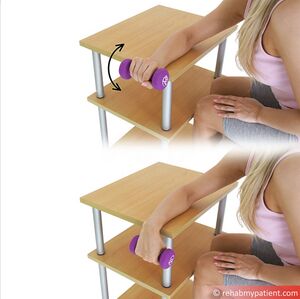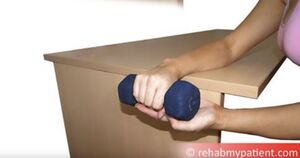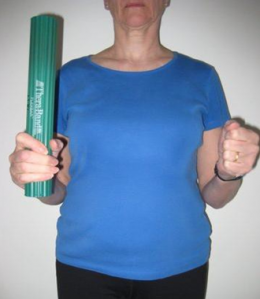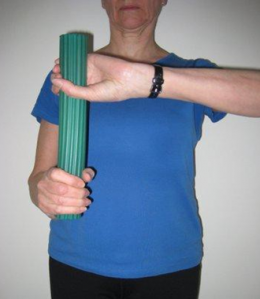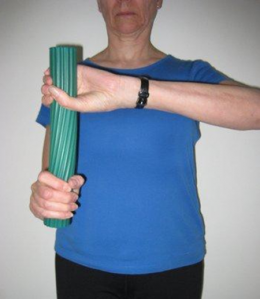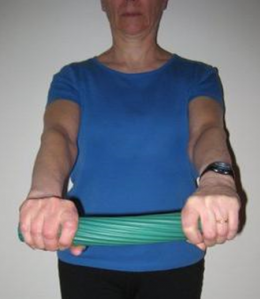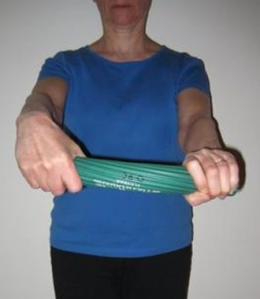Lateral Epicondyle Tendinopathy Toolkit: Section E - Exercise Prescription: Difference between revisions
Kim Jackson (talk | contribs) m (Text replacement - "[[Lateral Epicondyle Tendinopathy Toolkit: Appendix F - Outcome Measures" to "[[Lateral Epicondyle Tendinopathy Toolkit: Section C - Outcome Measures") |
Kim Jackson (talk | contribs) No edit summary |
||
| (33 intermediate revisions by 3 users not shown) | |||
| Line 1: | Line 1: | ||
<div class="editorbox"> | <div class="editorbox"> | ||
''' | '''Original Editor '''- [[User:Rishika Babburu|Rishika Babburu]] for '''BC Physical Therapy Tendinopathy Task Force:''' | ||
Dr. Joseph Anthony, Paul Blazey, Dr. Allison Ezzat, Dr. Angela Fearon, Diana Hughes, Carol Kennedy, Dr. Alex Scott, Michael Yates and Alison Hoens | |||
'''Top Contributors''' - {{Special:Contributors/{{FULLPAGENAME}}}} | |||
</div> | </div> | ||
== Introduction == | |||
Exercises for lateral epicondyle tendinopathy (LET) should be chosen according to patient preference, and the clinical evaluation. | |||
* | There is a large volume of clinical evidence that consistently supports the use of exercise for management of chronic LET. Studies evaluating strength-based exercise have demonstrated improvement in symptoms regardless of the muscle contraction-type (e.g. concentric, eccentric or isometric). Some evidence suggests that eccentric exercises may provide superior pain relief, but providing an exercise that the patient can tolerate (isometric, concentric or eccentric) is the most important consideration. | ||
* | |||
* | The summary of interventions suggests ([[Lateral Epicondyle Tendinopathy Toolkit: Section D - Summary of the Evidence|see section D]]) that clinicians strongly consider using local and upper limb kinetic chain exercises to support patients suffering from chronic LET. The following are examples of exercises to consider based upon the available literature | ||
== Concentric/Eccentric Home Exercise Program == | |||
Isotonic contraction includes [https://www.physio-pedia.com/Introduction_to_Therapeutic_Exercise?utm_source=physiopedia&utm_medium=related_articles&utm_campaign=ongoing_internal#cite_note-%3A0-1= Concentric] and [https://www.physio-pedia.com/Introduction_to_Therapeutic_Exercise?utm_source=physiopedia&utm_medium=related_articles&utm_campaign=ongoing_internal#cite_note-%3A0-1= Eccentric] contraction of muscles. | |||
'''Eccentric exercise''': | |||
* Eccentric exercises involve lengthening of the muscle. | |||
* Negative force of a muscle contraction (i.e. negative work) | |||
* Beneficial for tendons | |||
* Causes [[Delayed onset muscle soreness (DOMS)|delayed onset muscle soreness]] | |||
* Should take no less than 4 seconds | |||
'''Concentric exercise''': | |||
* Concentric exercises involve shortening of muscle length. | |||
* Positive force of a muscle contraction (i.e. positive work) | |||
* Used to build endurance and increase tolerance to exercise | |||
* Should take no longer than 3 seconds | |||
'''Frequency''': Daily, for 3-months | |||
'''Intensity''': Resistance will be dictated by patient’s current capacity (e.g. 1 Repetition Maximum - RM) | |||
< | * Water can be used as resistance if you do not have weights available. 1 litre of water = approx’ 1kg. | ||
* An option is to increase resistance by 0.1 kg (100ml water) weekly or as tolerated by the patient.<ref>Peterson M, Butler S, Eriksson M, Svardsudd K. [https://www.ncbi.nlm.nih.gov/pmc/articles/PMC3207303/ A randomized controlled trial of exercise versus wait-list in chronic tennis elbow (lateral epicondylosis).] Uppsala Journal of Medical Science. 2011; 116: 269-279</ref> | |||
'' | [[File:Wrist Extension with weightRMP.jpg|right|frameless]] | ||
'''Time''': Aim is to complete 3 sets of 15 reps (approx. 65% of 1RM) once per day. | |||
'''Technique:''' | |||
* Forearm should be supported in pronation with elbow in some flexion | |||
* Lift the weight by extending the wrist, then lower. Keep your forearm in contact with the surface al all times | |||
== | == Isometric Home Exercise Program == | ||
[https://www.physio-pedia.com/Introduction_to_Therapeutic_Exercise?utm_source=physiopedia&utm_medium=related_articles&utm_campaign=ongoing_internal#cite_note-%3A0-1= Isometric] exercise include muscle contraction without any movement or change in muscle length | |||
[[File:Isometric Wrist Exercise.jpg|right|frameless]] | |||
'''Frequency''': Once daily for 8-weeks | |||
'''Intensity''': Start at 20% Maximum Voluntary Contraction (MVC) progressively adding 5% every two weeks | |||
'''Time''': 30 seconds for 4 repetitions per day (30 secs rest between reps) | |||
In the protocol the reps were reduced to 3 but the contraction time increased to 45 seconds on alternating weeks. This was to generate a slow progression in the time-under-tension placed upon the lateral epicondyle tendon.<ref>Vuvan V, Vicenzino B, Mellor R, Heales LJ, Coombes BK. [https://pubmed.ncbi.nlm.nih.gov/31425384/ Unsupervised Isometric Exercise versus Wait-and-See for Lateral Elbow Tendinopathy.] Medicine and science in sports and exercise. 2020 Feb 1;52(2):287-95.</ref> | |||
'''Technique:''' | |||
< | * Forearm should be supported in pronation with elbow flexed to 90<sup>o</sup>, wrist in 30<sup>o</sup> extension. use your unaffected hand to place the weight in the affected hand. | ||
* Participant is instructed to hold the position for the allotted amount of time, before again removing the weight wit the unaffected hand. | |||
== Eccentric-only Home Exercise Program == | |||
'''Frequency''': 3 times per week, for 4-weeks | |||
'''Intensity''': Unclear | |||
'''Time''': 30s lowering phase for each repetition. Repeated for 10 repetitions and 3 sets. Take 1 minute between sets. | |||
Patients are instructed to raise the wrist as high as possible, using the opposite hand to support into the top position before performing a slow lowering (eccentric) contraction. | |||
Note that the prescription outlined would create 300-seconds of time-under-tension per set of exercise. | |||
< | Patients are also advised that this should elicit some mild pain, and to increase the level of resistance once the pain had gone, therefore maintaining mild pain for the 4-week intervention. They are to cease exercise if the pain became disabling.<ref>Stasinopoulos D, Stasinopoulos I. (2006) [https://pubmed.ncbi.nlm.nih.gov/16502745/ Comparison of effects of cyriax physiotherapy, a supervised exercise programme and polarized polychromatic non-coherent light (bioptron light) for the treatment of lateral epicondylosis.] Clinical Rehabilitation. 2006; 20(1): 12-23.</ref> | ||
'''Technique:''' | |||
* | * Holding a weight on the affected side, extend the wrist using the unaffected hand.[ADD IMAGE] | ||
* Allow the wrist to slowly flex (eccentric contraction of the wrist extensors). | |||
* | |||
== The “Tyler Twist” Eccentric Wrist Extensor Exercise == | |||
'''Frequency''': Daily, approximately 6 weeks. | |||
'''Intensity''': Increase resistance by using a thicker bar when the exercise is pain-free. | |||
'''Time''': Each rep should consist of around 4 seconds in the final phase of holding the wrist in a flexed position. This should be repeated for 3 sets of 15 once daily. 30 second rest between sets. | |||
'''Steps in the Tyler-twist''' | |||
* i. Hold the bar in the hand of the affected arm with the unaffected arm above (as shown | |||
* ii. With the affected wrist in full extension, twist the bar with the unaffected hand. | |||
* iii. Stretch both arms out so the elbows are fully extended | |||
* iv. Slowly allow the affected wrist to bend into flexion, allowing for an eccentric load of the wrist extensors<ref>Tyler T, Thomas G, Nicholas S, McHugh M. [https://pubmed.ncbi.nlm.nih.gov/20579907/ Addition of isolated wrist extensor eccentric exercise to standard treatment for chronic lateral epicondylosis: a prospective randomized trial.] Journal Of Shoulder And Elbow Surgery. Sep 2010; 19(6): 917-922.</ref> | |||
<br> | {| width="820" cellpadding="2" border="1" style="border: 1px solid darkgray;" | ||
|- | |||
| colspan="3" |<br> | |||
== | {| border="0" | ||
|- | |||
| width="266" |[[Image:LET Appendix C Fig3a.png|center|260x299px|Fig 3a of LET App C]]'''Figure 3A''' | |||
| width="266" |[[Image:LET Appendix C Fig3b.png|center|260x299px|Fig 3b of LET App C]]'''Figure 3B''' | |||
| width="266" |[[Image:LET Appendix C Fig3c.png|center|260x299px|Fig 3c of LET App C]]'''Figure 3C''' | |||
|- | |||
| width="266" |[[Image:LET Appendix C Fig3d.png|center|260x299px|Fig 3d of LET App C]]'''Figure 3D''' | |||
| width="266" |[[Image:LET Appendix C Fig3e.png|center|260x299px|Fig 3e of LET App C]]'''Figure 3E''' | |||
| | |||
* | |||
<br> | |||
<br> | <br> | ||
<br> | |||
|} | |||
|} | |||
{{#ev:youtube|xgTdtBrx2nc|width}}<ref>Tyler Twist. Available from:https://www.youtube.com/watch?v=xgTdtBrx2nc </ref> | |||
<br> | == Resources == | ||
*[[Lateral Epicondyle Tendinopathy (Tennis Elbow) Toolkit|Lateral Epicondyle Tendinopathy Toolkit page]] | |||
*[[Lateral Epicondyle Tendinopathy Toolkit: Section B - Clinical Assessment|LET Section B - Clinical Assessment of LET]] | |||
*[[Lateral Epicondyle Tendinopathy Toolkit: Section C - Outcome Measures|LET Section C - Outcome Measures]] | |||
*[[Lateral Epicondyle Tendinopathy Toolkit: Section D - Summary of the Evidence|LET Section D - Summary of the Evidence]] | |||
*[[Lateral Epicondyle Tendinopathy Toolkit: Section F - Manual Therapy|LET Section F - Manual Therapy]] | |||
*[[Lateral Epicondyle Tendinopathy Toolkit: Section G - LASER Dosage Calculation|LET Section G - LASER Dosage Calculation]] | |||
*[[Lateral Epicondyle Tendinopathy Toolkit: Section H - Braces, Splints, and Taping|LET Section H - Braces, Splints and Taping]] | |||
*[https://physicaltherapy.med.ubc.ca/physical-therapy-knowledge-broker/lateral-epicondyle-tendinopathy-let-toolkit/ UBC Lateral Epicondyle Tendinopathy (LET) Toolkit <br />] | |||
== References == | == References == | ||
| Line 146: | Line 150: | ||
[[Category:Clinical Guidelines]] | [[Category:Clinical Guidelines]] | ||
[[Category:Elbow - Guidelines]] | [[Category:Elbow - Guidelines]] | ||
[[Category:PT Knowledge Broker Project]] | |||
Latest revision as of 16:29, 14 January 2023
Original Editor - Rishika Babburu for BC Physical Therapy Tendinopathy Task Force:
Dr. Joseph Anthony, Paul Blazey, Dr. Allison Ezzat, Dr. Angela Fearon, Diana Hughes, Carol Kennedy, Dr. Alex Scott, Michael Yates and Alison Hoens
Top Contributors - Evan Thomas, Rishika Babburu, Kim Jackson, Admin, Wanda van Niekerk and Vidya Acharya
Introduction[edit | edit source]
Exercises for lateral epicondyle tendinopathy (LET) should be chosen according to patient preference, and the clinical evaluation.
There is a large volume of clinical evidence that consistently supports the use of exercise for management of chronic LET. Studies evaluating strength-based exercise have demonstrated improvement in symptoms regardless of the muscle contraction-type (e.g. concentric, eccentric or isometric). Some evidence suggests that eccentric exercises may provide superior pain relief, but providing an exercise that the patient can tolerate (isometric, concentric or eccentric) is the most important consideration.
The summary of interventions suggests (see section D) that clinicians strongly consider using local and upper limb kinetic chain exercises to support patients suffering from chronic LET. The following are examples of exercises to consider based upon the available literature
Concentric/Eccentric Home Exercise Program[edit | edit source]
Isotonic contraction includes Concentric and Eccentric contraction of muscles.
Eccentric exercise:
- Eccentric exercises involve lengthening of the muscle.
- Negative force of a muscle contraction (i.e. negative work)
- Beneficial for tendons
- Causes delayed onset muscle soreness
- Should take no less than 4 seconds
Concentric exercise:
- Concentric exercises involve shortening of muscle length.
- Positive force of a muscle contraction (i.e. positive work)
- Used to build endurance and increase tolerance to exercise
- Should take no longer than 3 seconds
Frequency: Daily, for 3-months
Intensity: Resistance will be dictated by patient’s current capacity (e.g. 1 Repetition Maximum - RM)
- Water can be used as resistance if you do not have weights available. 1 litre of water = approx’ 1kg.
- An option is to increase resistance by 0.1 kg (100ml water) weekly or as tolerated by the patient.[1]
Time: Aim is to complete 3 sets of 15 reps (approx. 65% of 1RM) once per day.
Technique:
- Forearm should be supported in pronation with elbow in some flexion
- Lift the weight by extending the wrist, then lower. Keep your forearm in contact with the surface al all times
Isometric Home Exercise Program[edit | edit source]
Isometric exercise include muscle contraction without any movement or change in muscle length
Frequency: Once daily for 8-weeks
Intensity: Start at 20% Maximum Voluntary Contraction (MVC) progressively adding 5% every two weeks
Time: 30 seconds for 4 repetitions per day (30 secs rest between reps)
In the protocol the reps were reduced to 3 but the contraction time increased to 45 seconds on alternating weeks. This was to generate a slow progression in the time-under-tension placed upon the lateral epicondyle tendon.[2]
Technique:
- Forearm should be supported in pronation with elbow flexed to 90o, wrist in 30o extension. use your unaffected hand to place the weight in the affected hand.
- Participant is instructed to hold the position for the allotted amount of time, before again removing the weight wit the unaffected hand.
Eccentric-only Home Exercise Program[edit | edit source]
Frequency: 3 times per week, for 4-weeks
Intensity: Unclear
Time: 30s lowering phase for each repetition. Repeated for 10 repetitions and 3 sets. Take 1 minute between sets.
Patients are instructed to raise the wrist as high as possible, using the opposite hand to support into the top position before performing a slow lowering (eccentric) contraction.
Note that the prescription outlined would create 300-seconds of time-under-tension per set of exercise.
Patients are also advised that this should elicit some mild pain, and to increase the level of resistance once the pain had gone, therefore maintaining mild pain for the 4-week intervention. They are to cease exercise if the pain became disabling.[3]
Technique:
- Holding a weight on the affected side, extend the wrist using the unaffected hand.[ADD IMAGE]
- Allow the wrist to slowly flex (eccentric contraction of the wrist extensors).
The “Tyler Twist” Eccentric Wrist Extensor Exercise[edit | edit source]
Frequency: Daily, approximately 6 weeks.
Intensity: Increase resistance by using a thicker bar when the exercise is pain-free.
Time: Each rep should consist of around 4 seconds in the final phase of holding the wrist in a flexed position. This should be repeated for 3 sets of 15 once daily. 30 second rest between sets.
Steps in the Tyler-twist
- i. Hold the bar in the hand of the affected arm with the unaffected arm above (as shown
- ii. With the affected wrist in full extension, twist the bar with the unaffected hand.
- iii. Stretch both arms out so the elbows are fully extended
- iv. Slowly allow the affected wrist to bend into flexion, allowing for an eccentric load of the wrist extensors[4]
| ||||||||
Resources[edit | edit source]
- Lateral Epicondyle Tendinopathy Toolkit page
- LET Section B - Clinical Assessment of LET
- LET Section C - Outcome Measures
- LET Section D - Summary of the Evidence
- LET Section F - Manual Therapy
- LET Section G - LASER Dosage Calculation
- LET Section H - Braces, Splints and Taping
- UBC Lateral Epicondyle Tendinopathy (LET) Toolkit
References[edit | edit source]
- ↑ Peterson M, Butler S, Eriksson M, Svardsudd K. A randomized controlled trial of exercise versus wait-list in chronic tennis elbow (lateral epicondylosis). Uppsala Journal of Medical Science. 2011; 116: 269-279
- ↑ Vuvan V, Vicenzino B, Mellor R, Heales LJ, Coombes BK. Unsupervised Isometric Exercise versus Wait-and-See for Lateral Elbow Tendinopathy. Medicine and science in sports and exercise. 2020 Feb 1;52(2):287-95.
- ↑ Stasinopoulos D, Stasinopoulos I. (2006) Comparison of effects of cyriax physiotherapy, a supervised exercise programme and polarized polychromatic non-coherent light (bioptron light) for the treatment of lateral epicondylosis. Clinical Rehabilitation. 2006; 20(1): 12-23.
- ↑ Tyler T, Thomas G, Nicholas S, McHugh M. Addition of isolated wrist extensor eccentric exercise to standard treatment for chronic lateral epicondylosis: a prospective randomized trial. Journal Of Shoulder And Elbow Surgery. Sep 2010; 19(6): 917-922.
- ↑ Tyler Twist. Available from:https://www.youtube.com/watch?v=xgTdtBrx2nc
